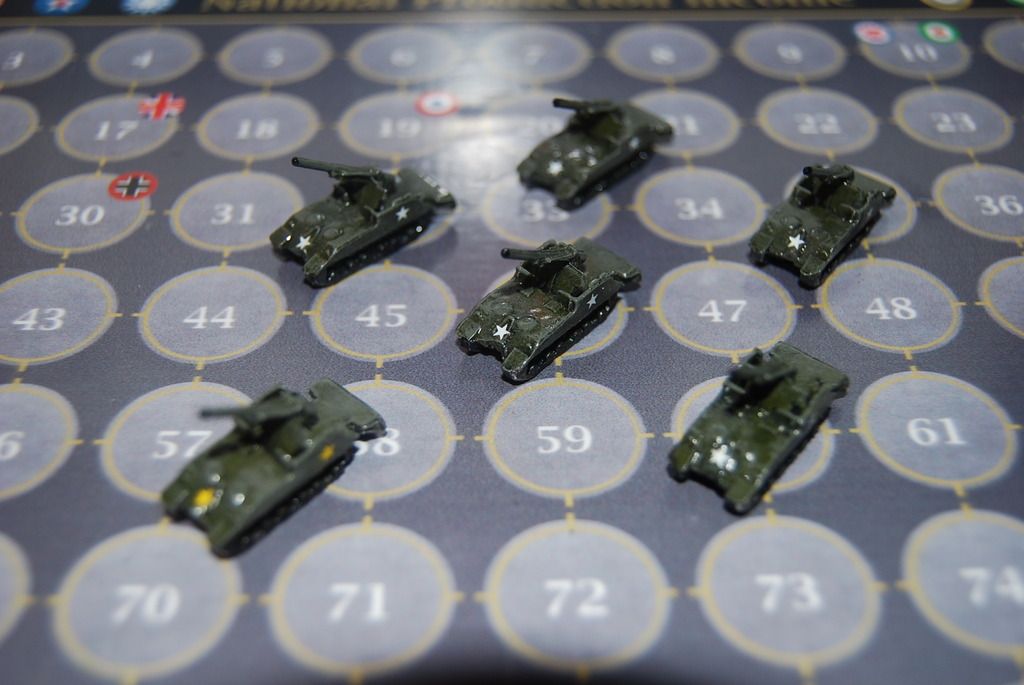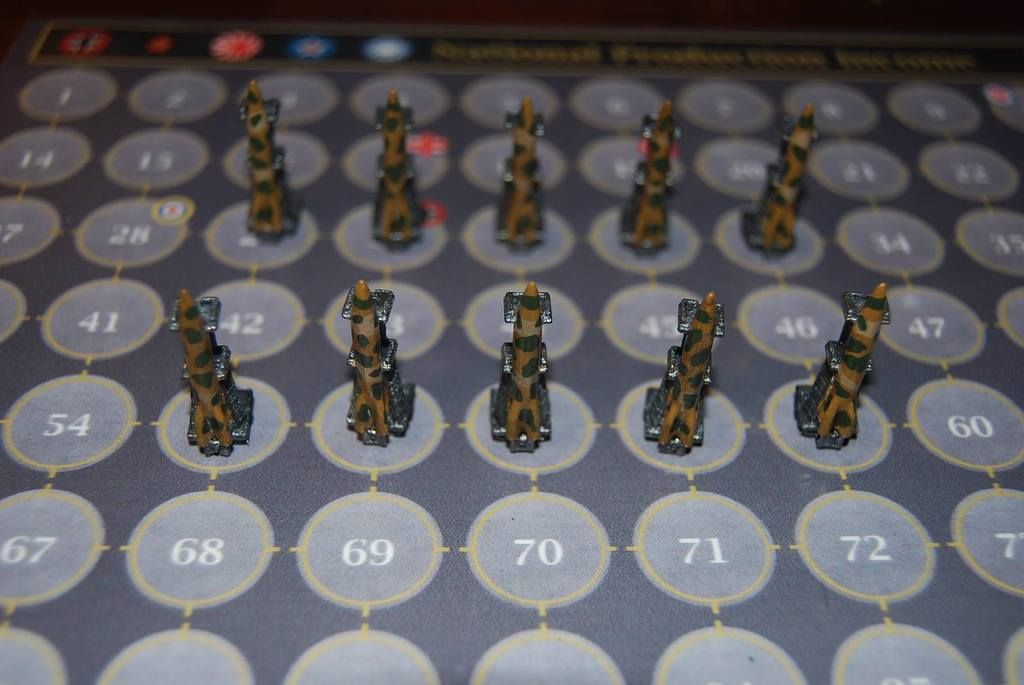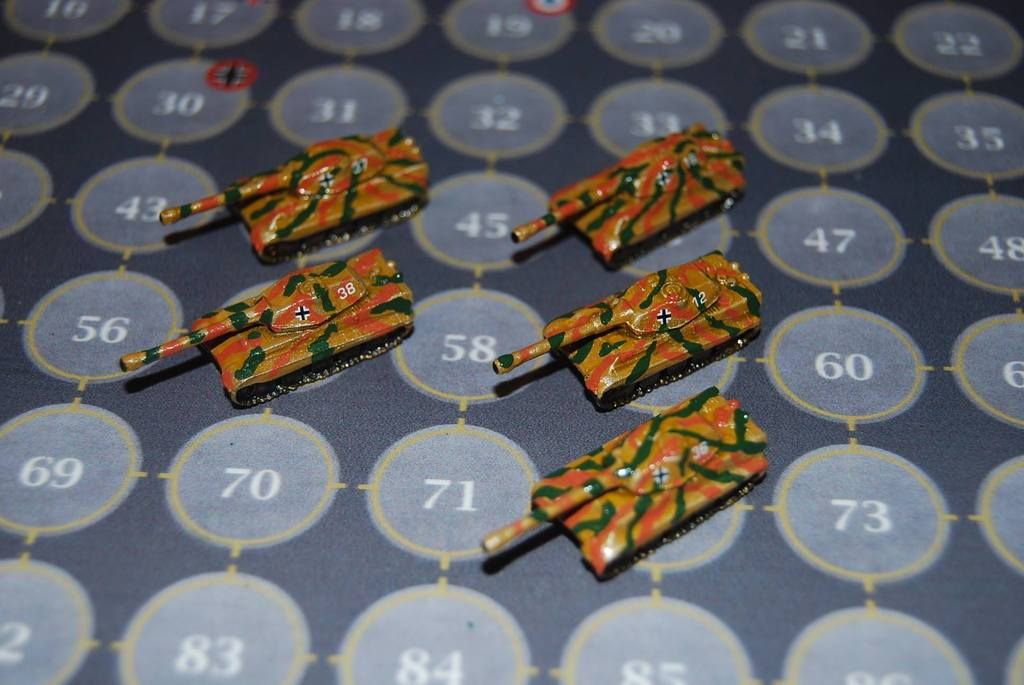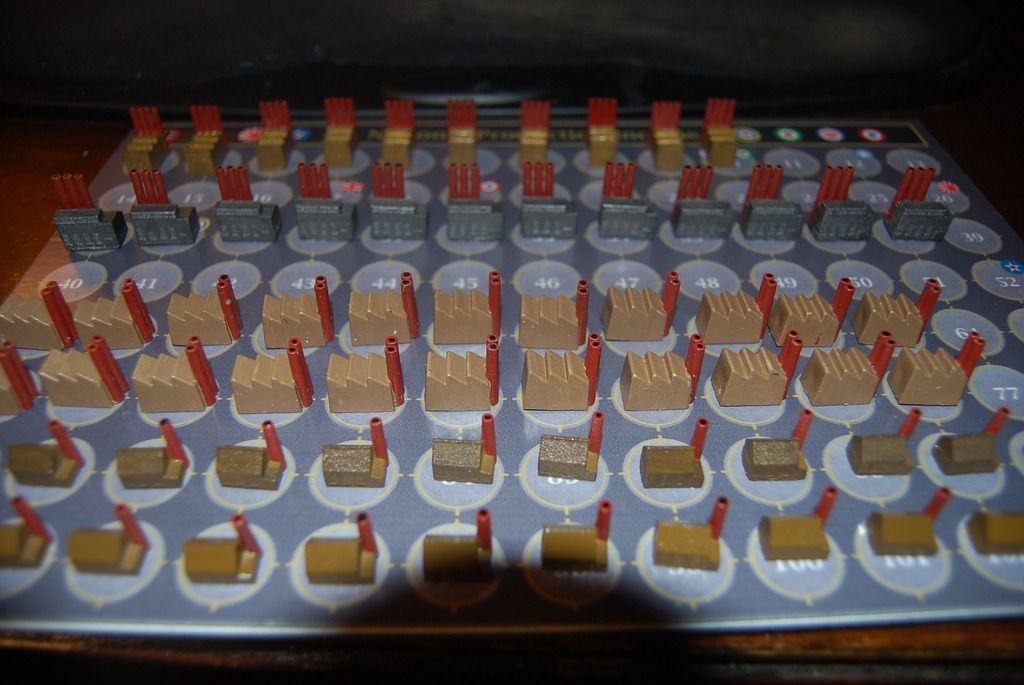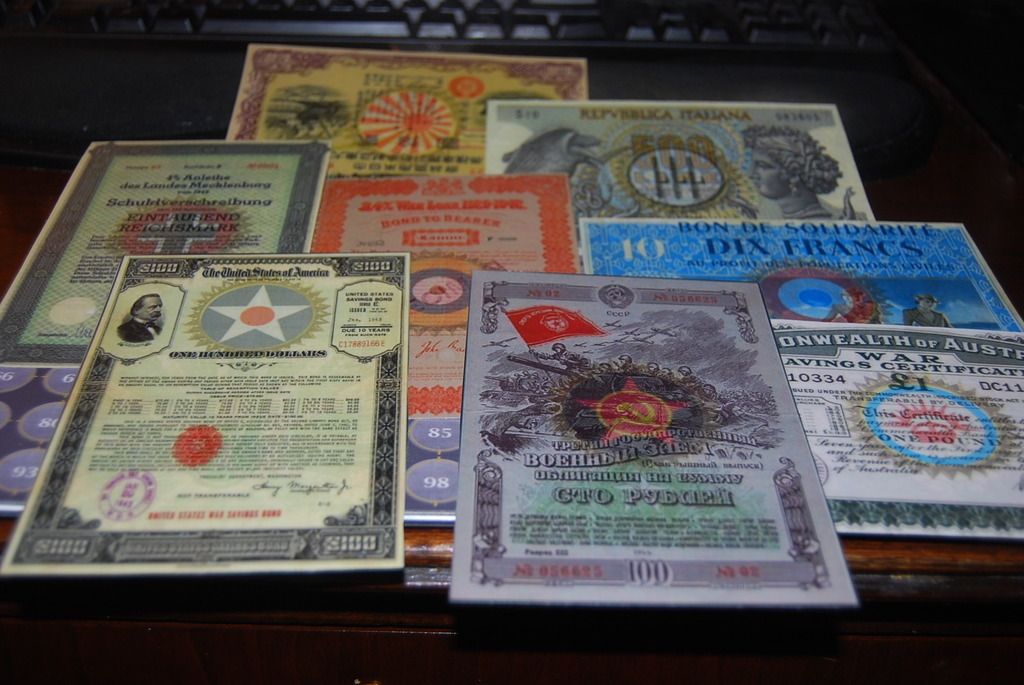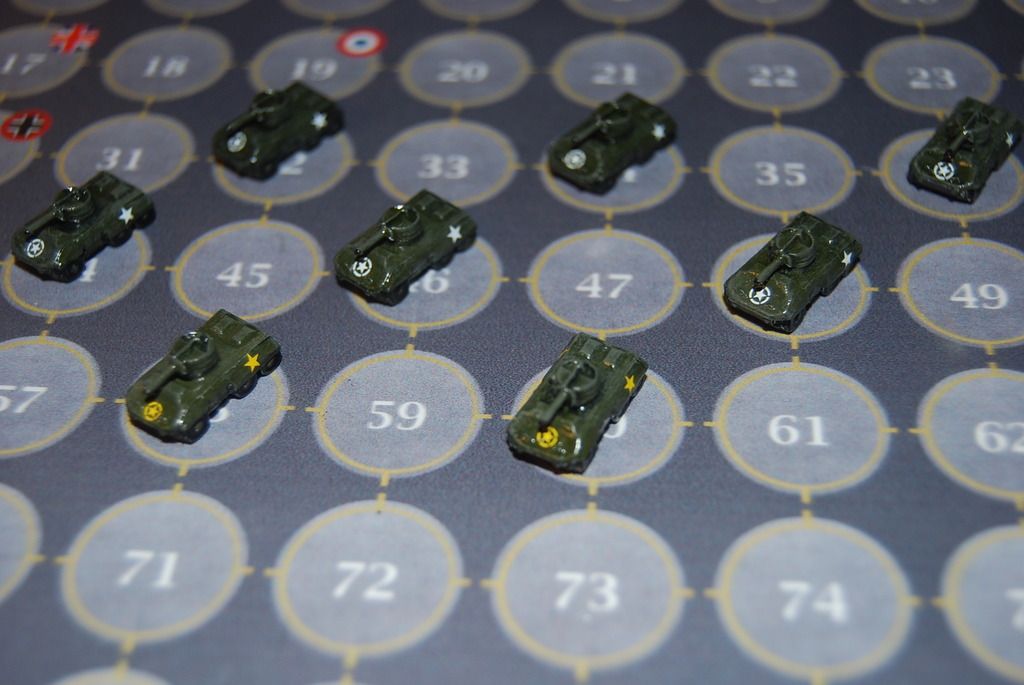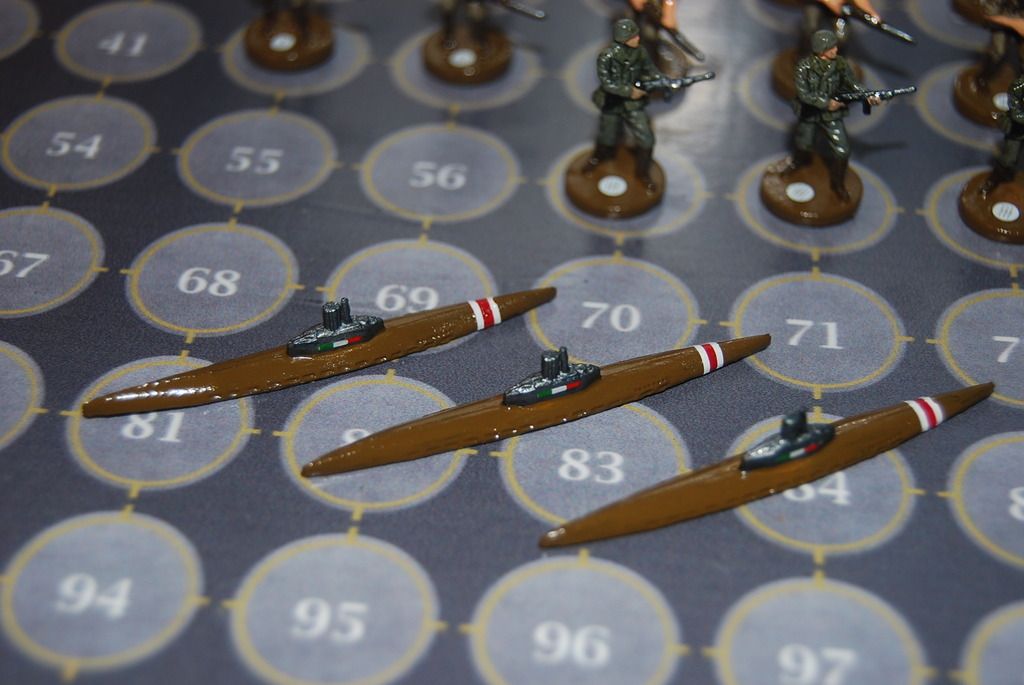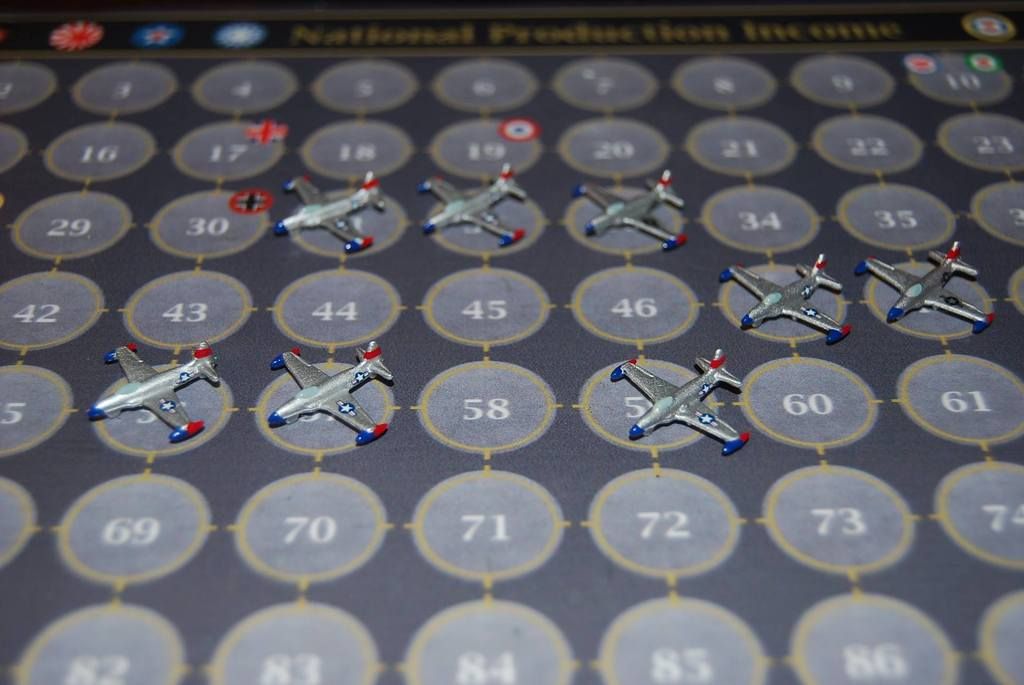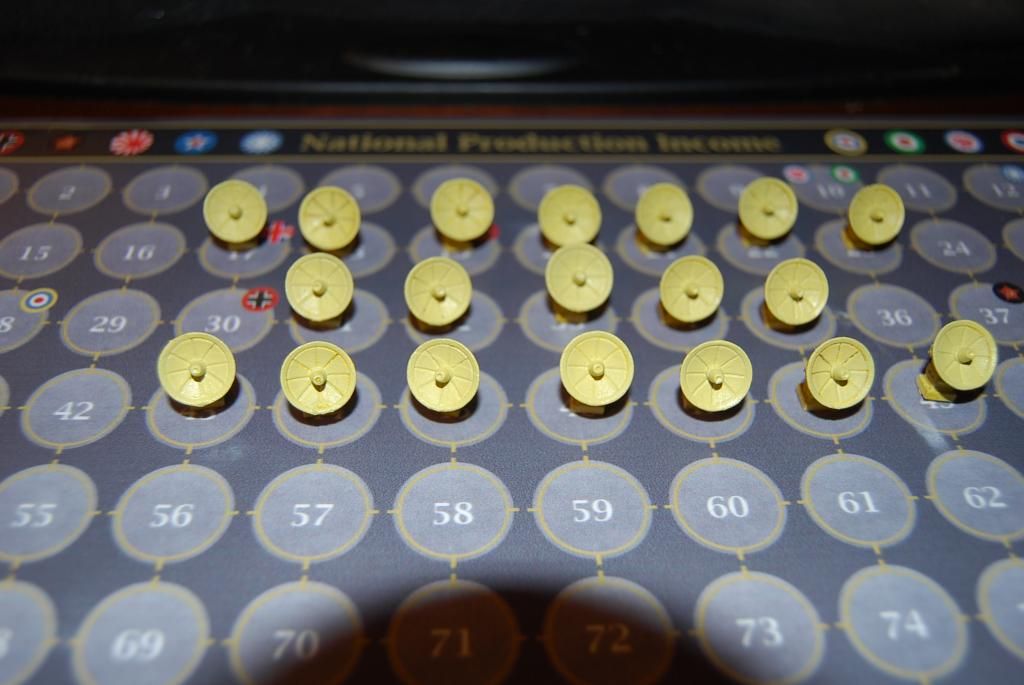Or maybe noting zombie kills per nation and for every X number of kills tech is achieved.
Drako's Tanks House Rule - Tank Classes
-
Narvik, the pieces with a gun minus a turret in the German Army were not tank destroyers or a cheaper tank. They were mobile artillery or the more correct term “Self-propelled artillery.”
The German Army had Self-Propelled Artillery in their Armor divisions and Mechanized Infantry divisions from the beginning. Their doctrine for that equipment was in keeping with their doctrine for non-self-propelled artillery. Never did they consider that a way to cut corners on costs, ect…in fact towards the end of the war their tanks increased in size…hence the Mark 5 “Panther” and the Tiger II.
The more additional units the more of a chance that there could be a misunderstanding in a game. If you have “Tank Destroyers” and “Self-Propelled Artillery,” then you need completely different sculpts. Plus you don’t want someone getting confused with your other tank sculpts.
-
For understandable reasons, armoured vehicles evolved more quickly during WWII than at any time before or since. One of the side effects of this rapid evolution was that it resulted in a vast number of armoured vehicle types, which produced considerable confusion over where some types ended and others began. The confusion still exists today because there’s no hard-and-fast way of defining precisely where the dividing lines are – but for whatever it’s worth, here’s how I interpret and categorize these vehicles.
First, there are the vehicles that fall on what proved to be the main evolutionary line of tanks, which began in WWI with the Renault FT and which continues in the present day in such forms as the M1 Abrams. These are the vehicles with a standard tank configuration consisting of an armoured hull with the driver at the front, the engine at the back and a caterpillar track on each side, on top of which sits a rotating armoured turret containing the tank’s main gun, the tank’s commander, and usually other crew members such as a loader and a gunner. In WWII, this general configuration was expressed in such variations as light tanks, medium tanks, heavy tanks and super-heavy tanks such as the Maus, plus the British categories of cruiser tanks and infantry tanks. All basically contained the same elements, with their differences being mainly in the areas of scale and of ratios.
The lightest tanks weren’t much use against armour, and the heaviest tanks were mainly intended for use against armour, but all conventional tanks had in common one important feature: they carried a direct-fire main gun. This means that their gun was meant to shoot in a straight line at targets that the gunner could see with his own eyes and which were located at short to medium ranges. This type of gun is fundamentally different from howitzer-type artillery, which operates on the principle of indirect fire: howitzers fire shells on a high-arc trajectory against targets which the gunner typically can’t see with his own eyes (the fire needs to be targeted by other means) and which is often intended to deliver plunging fire against targets (such as trenches) which are difficult to attack with direct-fire weapons.
The direct-fire guns of WWII tanks also tended to be – but were not always – high-velocity guns (especially compared with howitzers, which tend to be low-velocity weapons). High-velocity guns are well suited to penetrating armour at short to medium ranges because the force delivered by a projectile is equal to its mass times the square of its velocity – meaning that an increase in shell speed gives better results than an increase in shell size and weight. Generally speaking, high-velocity guns were the best choice for a WWII tank because they were very effective against armour when they fired armour-piercing rounds, and because in a pinch they could also be reasonably effective as infantry-support weapons when firing high-explosive rounds. This made them more versatile than low-velocity tanks guns, which were fine as as infantry-support weapons but ineffective as armour-piercing anti-tank weapons.
So much for conventional tanks. Now we get into the messy territory of tankettes, tank destroyers, assault guns and self-propelled artillery.
Tankettes don’t need much analysis: they were mostly small, open-topped tracked vehicles that served as troop carriers or light weapon carriers, they were popular in the 1920s because they were cheap, and combat experience in WWII quickly showed them to be useless.
Tank destroyers in WWII more or less fell into two types: German-type and American-type, for want of a better designation. The classic German-type tank destroyers were the Jagdpanther and Jagdtiger, which were basically Panther and Tiger chassis caring an armoured box rather than a rotating turret. Their advantage was that they were cheaper than turreted tanks, they could carry a bigger gun, and their front superstructure could be more heavily armoured. Their disadvantage was that their turretless design required the whole vehicle to be turned in order to aim at a target, and that they tended to be slow. I’m less familiar with American tank destroyers, but my understanding is that they tended to be fast, fairly light (meaning not well armoured) vehicles, some designs having turrets and some being opened-topped. Tank destroyers had high-velocity guns, since their primary job was to kill armoured vehicles. Turretless tank destroyers pretty much disappeared after WWII, but the Swedish Stridsvagn 103, or S-tank, which operated in the 1960s and 1970s, was based on their configuration.
The basic thing to remember about assault guns and self-propelled artillery is that these armoured vehicles weren’t intended to fight other armoured vehicles (unlike tank destroyers, the whole point of which was their anti-armour function). Self-propelled artillery, which survives to this day, is fairly easy to define: it has more or less the same functions as towed artillery, but it can move around the battlefield under its own power, on the same terrain as tanks (because it too has tracks), and it offers its crew a certain degree of armour protection. SPA typically functions in an indirect-fire role, firing low-velocity, high-explosive shells, often over medium or long distances. Assault guns, unlike SPA, didn’t outline WWII. They tended to carry large-caliber, low-velocity, direct-fire guns mean to attack targets at short ranges, in direct support of infantry. They were useful against certain types of fortifications, an application for which a powerful explosive charge delivered at low velocity was more useful than a mostly solid armour-piercing shell delivered at high velocity.
These multiple vehicle types are interesting to study, but the distinctions between them are far too complicated to all be depicted in a game like A&A. The list I gave above (light tanks, medium tanks, heavy tanks, super-heavy tanks, cruiser tanks, infantry tanks, tankettes, German-type tank destroyers, American-type tank destroyers, assault guns and self-propelled artillery) adds up to twelve different categories, which is almost the same number of unit types found in A&A 1940. A little more variety – say, a couple of extra tank types – would be fun and practical, but going further than that would probably be too much.
-
Just my two cents on US vs Germany tank destroyers:
A US sherman medium tank with a main gun able to pierce Panther or Tiger armour was called a Tank Destroyer.
It is like mounting a 85 mm gun on a T-34 Russian medium Tank instead of a 76 mm, would you also name it a Tank Destroyer?The Sherman Firefly was a tank used by United Kingdom and some Commonwealth and Allied armoured formations in the Second World War. It was based on the US M4 Sherman but fitted with the powerful 3-inch (76.2 mm) calibre British 17-pounder anti-tank gun as its main weapon. Originally conceived as a stopgap until future British tank designs came into service, the Sherman Firefly became the most common vehicle mounting the 17-pounder in the war.
Though the British expected to have their own new tank models developed soon, British Major George Brighty championed the already rejected idea of mounting the 17-pounder in the existing Sherman. With the help of Lieutenant Colonel Witheridge and despite official disapproval, he managed to get the concept accepted. This proved fortunate, as both the Challenger and Cromwell tank designs experienced difficulties and delays.
After the difficult problem of getting the gun to fit in the Sherman’s turret was solved by W.G.K. Kilbourn, a Vickers engineer, the Firefly was put into production in early 1944, in time to equip Field Marshal Montgomery’s 21st Army Group for the Normandy landings. It soon became highly valued as the one of British tank capable of defeating at long range the Panther and Tiger tanks it faced in Normandy. In recognition of this, German tank and anti-tank gun crews were instructed to attack Fireflies first. Between 2,100 and 2,200 were manufactured before production wound down in 1945.
https://en.m.wikipedia.org/wiki/Sherman_Firefly
German’s Tank Destroyers were Assault Guns, as Marc said: no turret on top, just the main gun.
I’m thinking about Stug III and IV which can probably qualified as such, along with Jagdpanther and Jagdtiger.The Sturmgeschultz IV (StuG IV) (Sd.Kfz. 167), was a German assault gun variant of the Panzer IV used in the latter part of the Second World War. Identical in role and concept to the highly successful StuG III assault gun variant of the Panzer III, both StuG models were given an exclusively tank destroyer role in German formations and tactical planning in the last two years of the war, greatly augmenting the capability of the dwindling tank force available to the German army on the Eastern and Western fronts.
https://en.m.wikipedia.org/wiki/Sturmgeschütz_IV
So, US Tank Destroyer and Germany Tank Destroyer have the same name but are two different weapons.
-
@Baron:
German’s Tank Destroyers were Assault Guns, as Marc said
I did not say that German’s tank destroyers were assault guns. Tank destroyers and assault guns were two completely different types of weapons, as I explained in my previous post.
-
@CWO:
@Baron:
German’s Tank Destroyers were Assault Guns, as Marc said
I did not say that German’s tank destroyers were assault guns. Tank destroyers and assault guns were two completely different types of weapons, as I explained in my previous post.
There is a distinction I don’t understand in this, I believe:
The classic German-type tank destroyers were the Jagdpanther and Jagdtiger, which were **basically Panther and Tiger chassis caring an armoured box rather than a rotating turret. Their advantage was that they were cheaper than turreted tanks, they could carry a bigger gun, and their front superstructure could be more heavily armoured. **Their disadvantage was that their turretless design required the whole vehicle to be turned in order to aim at a target, and that they tended to be slow.
I thought Jagdpanther and Jagdtiger were considered Assault Guns, too.
-
Also, from a few games houseruled with much more vehicules, your people need to be into WWII mechanized units to tell little difference between Tanks and other armoured vehicules.
I came to introduced an Assault Guns units, acting both as indirect fire infantry support units and a direct fire anti-tank unit, such as Stug III sculpt from HBG.
I named it Mechanized Artillery, and the way to recognized it amongst Tank was the turretless feature.
Otherwise, my gamers people didn’t want more special tanks, smaller or bigger.
It was not easy to distinguish between them for untrained eyes, without putting them side by side to compare.
My Tigers and Panthers sculpts remains blurry even for some which are heavy boardgame player.So, this is my little piece of advice. Too much similar units can be detrimental if people are not ready to be focus and wanting more WWII units depictions.
Once, one player blamed me because I used on setup the specific German TP unit instead of a generic which was similar to japanese. He thought it was a Cruiser or a Destroyer, I cannot remember, but said it loose it too easily (arguing he would have put more protection if he had known it was only a TP).
The only ground unit added to complete my roster, so you get a better picture of my A&A :
@Baron:Here is a much more A&A paradigm rules version for a single type of Mobile Artillery unit (SPA / SPG /TD) that I revised from my previous post:
MECHANIZED ARTILLERY (Assault Gun)
Attack: 2-3
Defense: 2-3
Move: 2
Cost: 5
Can blitz when at least a Tank is present in a group of units.
It means that any number of MechArt can blitz when a Tank is blitzing. In addition, this Tank can be already paired to a MechInf while blitzing.
Infantry Support: Give +1A to a paired Infantry or Mechanized Infantry.
Tank Hunter as a Tank Support ability: Get +1A/D when paired to a Tank.This unit on attack cannot give and get both bonus as Inf support & Tank support when teamed up with both MI and Tk.
You must choose which bonus is use, and can change during the battle round, switching from one to the other according to which unit the Mechanized Artillery is paired to.I think it could be better balance and nearer A&A pairing bonus.
Some may prefer give +1 on Defense only when paired to a Tank but this unit will be much more appealing if it get +1A also.
I think it will be nearer the historical records about all kind of Mechanized Artillery.
Germany for instance built a lot of them and even much more than Tanks during WWII, specially StuGIII type.
And during the game, it will be a way to get an optimized built by having a Mechanized Artillery paired to an already existing Tank.
It will follow the same progression than WWII, this unit getting more and more popular as the war evolved.In itself it will be weaker (A2D2C5) but cheaper than medium Tank (A3D3C6).
But was useful for both Infantry unit and Tank as support unit.
And dangerous against Tank, hence gaining the bonus on A/D making them as valuable than a regular Tank but keeping the need to buy Tank to get Mechanized Artillery such a useful unit on offense and defense.I also learned that during WWII both Artillery division (supporting Inf) and Panzer division were having struggles with the Army Chief Command over StuGs being part of their unit instead of the other.
Even this aspect can be depicted by the dual bonus for being paired to Inf and MechInf or with Armor.
-
There is an expansion set on HGB for the Amerika game called Bring In the Heavies. It has 12 tank sculpts with rules on how they are to be used. I know you want to make your own rules but maybe you could take a quick look there for some ideas. I tried to post a link but I can’t.
-
CWO Mark previously wrote,
“Tank destroyers in WWII more or less fell into two types: German-type and American-type, for want of a better designation. The classic German-type tank destroyers were the Jagdpanther and Jagdtiger, which were basically Panther and Tiger chassis caring an armoured box rather than a rotating turret. Their advantage was that they were cheaper than turreted tanks, they could carry a bigger gun, and their front superstructure could be more heavily armoured. Their disadvantage was that their turretless design required the whole vehicle to be turned in order to aim at a target, and that they tended to be slow.”
I agree and disagree…the Jagdpanther and Jagdtiger shared chassis. But these late war models were not tank destroyers. They were self-propelled artillery and used as artillery. It’s no different than the modern day US Army M1097 Paladin.
A quick search through something like google will validate this historical fact…“Towards the end of September 1939, Krupp designed the “first real self-propelled artillery piece”, the Sonderkraftfahrzeug 165/1 (Special Purpose Vehicle 165/1, abbreviated Sd.Kfz. 165/1). The Sd.Kfz. 165/1 was similar in design to the Heuschrecke, but did not have the chassis-mounted launching mechanism to remove the turret.[2] After a series of tests, the Sd.Kfz…” Wikipedia
I am a senior Army officer and currently serving. I have actual military training. I think sometimes people don’t understand certain military concepts.
Self-propelled artillery can of course conduct direct fire (like the concept of a tank destroyer), but that idea is practically and mostly a US doctrinal concept in WWII. Never throughout the war did the German Army (Heer) think of using self-propelled artillery for direct fire as its primary purpose. The Jadgpanther was an artillery tube. Obvioulsy the gun could be lowered and directly aimed at an approaching enemy T34 Russian tank. But it’s normal application was indirect fire in coordination with a forward Field Artillery Observer who may or may not have been attached to a mechanized unit. Kind of how in Axis and Allies we let the Artillery pair with a infantry unit or mech infantry unit for the higher dice roll.
-
The Jadgpanther was an artillery tube. Obvioulsy the gun could be lowered and directly aimed at an approaching enemy T34 Russian tank. But it’s normal application was indirect fire in coordination with a forward Field Artillery Observer who may or may not have been attached to a mechanized unit.
The Jagdpanther was armed with an 88mm Pak 43 anti-tank gun, designed for direct fire at high velocity on a flat trajectory. It was not an artillery piece intended for indirect fire.
-
I stand corrected CWO Marc. Thanks for providing the correct information.
-
I apologize for being inactive the past few days. My college classes have really heated up recently. In any spare time I have, I will see about making changes to make things simpler. I feel like most people are having the most problems with the pairing of units and mainly the entire idea of tank destroyers. With that being said, I will ponder the idea of removing them completely.
On a complete side note, I am really curious to see what you all think about the German SturmTiger. Mainly I am curious about what CWO Marc and Ichabod have to say about it but everybody is welcome to comment on it. I personally don’t know a lot about it. Just that it had a very large mortar style short barrel cannon and, if I’m not mistaken, was supposed to replace the StuG line of assault guns that were being engineered more towards attacking enemy tanks instead of infantry support. Like the StuG III Ausf. A, was geared more towards infantry support but later StuG IIIs were more towards fighting tanks. So Germany needed to replace them. Enter the SturmTiger. However, I could be wrong.
-
Here’s one idea for a set of units for 1940 Global with relatively simple rules and three types of tanks:
| Unit Type | Cost | Attack | Defense | Move | Blitz | Special Ability |
| Reg. Infantry | $3 | 1 | 2 | 1 | No | n/a |
| Artillery | $4 | 2 | 2 | 1 | No | +1 atk for 1 paired reg. inf. |
| Mech. Infantry | $4 | 1 | 2 | 2 | No | n/a |
| Mech. Artillery | $5 | 2 | 2 | 2 | No | +1 atk for 1 paired mech. inf. |
| Light Tank | $5 | 2 | 1 | 3 | Yes | n/a |
| Medium Tank | $6 | 3 | 3 | 2 | Yes | +1 atk for 1 paired tac. bomber |
| Heavy Tank | $8 | 4 | 3 | 2 | Yes | Your entire stack absorbs 1 free hit in 1st round of combat if enemy has any tanks |I may not have the balance entirely right, as I’m not a Global 1940 player, but the key idea is that categories of units match up with a particular ability. All tanks can blitz, and only tanks can blitz. All artillery can give +1 attack to an infantry, and only artillery can do that. All mechanized units can move exactly two spaces, etc.
If my numbers are right, then light tanks will be inefficient for the price unless you really need that third unit of speed – instead of paying $10 for a pair of light tanks that get 4 pips on offense and 2 pips on defense, you could pay $9 for a mech. inf. and mech. art. that get 4 pips on offense and defense.
Medium tanks are exactly as written in standard 1940 Global, except that they do not support blitzes for mechanized infantry.
Heavy tanks are inefficient for the price unless you’ve (a) got a fairly large stack to work with, e.g., mix in 1 heavy tank with 3 or 4 smaller tanks, and (b) know you’ll be facing some enemy tanks. Note that no matter how many heavy tanks you have in a stack, you can only absorb 1 free hit per territory per turn.
Suppose you have a budget of $48 to buy tanks. Six heavy tanks would give you 24 pips of offense, 18 pips of defense, and an effective 7 hit points, as long as you’re facing at least 1 enemy tank. That’s a terrible deal, though, because for the same price you could get eight medium tanks, giving you 24 pips of offense, 24 pips of defense, and 8 hit points. An interesting mix (assuming you buy only tanks) is to get 1 heavy tank, 5 medium tanks, and 2 light tanks. For the same $48, that buys you 23 pips of offense, 20 pips of defense, 9 hit points, an advantageous replacement schedule (if you take some hits, you lose the light tanks first, which are cheaper to replace, and can catch up to your front lines faster) and the ability to pick up a far-away territory now and then with your light tanks.
-
On a complete side note, I am really curious to see what you all think about the German SturmTiger. Mainly I am curious about what CWO Marc and Ichabod have to say about it but everybody is welcome to comment on it. I personally don’t know a lot about it. Just that it had a very large mortar style short barrel cannon and, if I’m not mistaken, was supposed to replace the StuG line of assault guns that were being engineered more towards attacking enemy tanks instead of infantry support. Like the StuG III Ausf. A, was geared more towards infantry support but later StuG IIIs were more towards fighting tanks. So Germany needed to replace them. Enter the SturmTiger. However, I could be wrong.
I have a very busy day lined up today, so for the moment I only have time for a quick initial comment on this. My feeling is that getting into the nitty-gritty of how two very specific German armoured vehicles compared to each other is getting too far ahead of what you should be looking at first, which is the general concept of how general classes of fighting machines are supposed to represent and how they should be modeled in A&A. In other words, I think it’s premature to focus on whether the SturmTiger should be considered an assault gun or a tank destroyer relative to the Stug III assault gun (and even more specifically the Stug III Ausf. A, which is an even finer gradation) before you’ve settled the larger question of what function tank destroyers and assault guns in general are supposed to play in the game. Remember that in Global 1940, there are many different sculpts (one per nation) that are used to depict each unit type, but that they’re all considered to have identical performances under the rules, despite the fact that they don’t always depict actual models that were actually equivalent in WWII.
-
Argothair,
I would play with this house rule as is in order to war game it…just finding the different sculpts so that one could clearly see the difference between a light tank and a med. tank might be a challenge. I got into too much of a discussion over tank destroyers vs. self-propelled artillery instead of sticking to your house rule idea.
Further comments:
Perhaps you might want to consider the Heavy Tank costing 10 or 11 IPCs. Reason being if the Tank gets 1 free hit and its attack roll is as high as a Strat bomber or a Tac. bomber, then it’s actually almost better than a plane. King Tiger IIs were expensive tanks…so were the IS-2 Stalin tanks. At a cost of 8 IPCs, it might become a “broken” unit (meaning people only buy this one single unit) rather than a mix of units.
Did you drop permitting mech to blitz when paired with a tank? Or is it implied that it has to pair (but by saying “no” you mean it can’t blitz by itself). What about requiring Light tanks to pair with at least a mech. or another Light tank in order to blitz?
I’d request to let the Mech. Artillery pair with infantry also for supporting infantry attack rolls at 2. Mech. Infantry fight dismounted, just like normal infantry. I think this additional advantage is fair because of the higher 5 IPC cost. I can imagine a modern Paladin howitzer supporting mech infantry just the same as infantry.
Mech. today and back then have Armor Personnel Carriers, but other than the crew (driver, truck commander, and gunner which is usually a machine gun or the modern day Bradley which has more firepower), the infantry squad in the back dismount.
Respectfully,
Ichabod -
Hi Ichabod,
Yes, the sculpts are definitely a challenge! You might wind up having to use paint or chips or stickers to indicate the different tank classes, rather than unique sculpts, especially for a playtest.
I agree with you on the Mech. Artillery supporting Reg. Infantry. – you’re correct both as a matter of mechanics and history!
I recommend dropping Mech. Inf’s ability to blitz, yes. For simplicity / ease-of-use, I’d like to see only tanks be able to blitz. That said, if you prefer allowing Mech. Inf. to blitz with support from a tank (any tank), that’s not going to break this variant; it’ll still work.
Notice that even a huge stack of Heavy Tanks only soaks a combined total of 1 free hit. Unlike 3 battleships, which will soak 3 hits, 3 Heavy Tanks will only soak 1 hit, so I’d be surprised if people only buy that one single unit at 8 IPCs. Unlike planes, heavy tanks can’t be used to attack or defend ships, can’t transport themselves across sea zones, can’t be used for efficient light trading, and have only 2 movement. That said, I considered pricing heavy tanks at $9, and if you might even be able to get away with a cost of $10 if you feel strongly about that.
-
An idea that might be useful to consider is this one, which would help keep within reasonable limits the potential for excess complexity in introducing new specialized house-ruled units. The basic idea would be: all the player nations in Global 1940 (except China, of course) would all have access to all the standard unit types that exist in Global 1940, but only some nations would have access to specialized house-ruled units. This would get around the problem mentioned earlier in this thread, which is the “where will I get a sculpt to represent (for example) an ANZAC heavy tank?” problem. Answer: ANZAC won’t get a heavy tank, because they had no such weapons in WWII (which is why no such sculpt exists in the first place). The two most likely candidates for heavy tanks (to continue with this example) would be Germany and the USSR, which both conveniently have heavy tank sculpst in A&A 1941. Likewise, the old-style German Panther sculpt from the early A&A editions can plausibly be used to represent a Jagdpanther tank destroyer, since it looks appreciably different from the current Panther sculpt.
-
Here’s one idea for a set of units for 1940 Global with relatively simple rules and three types of tanks:
| Unit Type | Cost | Attack | Defense | Move | Blitz | Special Ability |
| Reg. Infantry | $3 | 1 | 2 | 1 | No | n/a |
| Artillery | $4 | 2 | 2 | 1 | No | +1 atk for 1 paired reg. inf. |
| Mech. Infantry | $4 | 1 | 2 | 2 | No | n/a |
| Mech. Artillery | $5 | 2 | 2 | 2 | No | +1 atk for 1 paired mech. inf. ||
| Light Tank | $5 | 2 | 1 | 3 | Yes | n/a |
| Medium Tank | $6 | 3 | 3 | 2 | Yes | +1 atk for 1 paired tac. bomber |
| Heavy Tank | $8 | 4 | 3 | 2 | Yes | Your entire stack absorbs 1 free hit in 1st round of combat if enemy has any tanks |I may not have the balance entirely right, as I’m not a Global 1940 player, but the key idea is that categories of units match up with a particular ability. All tanks can blitz, and only tanks can blitz. All artillery can give +1 attack to an infantry, and only artillery can do that. All mechanized units can move exactly two spaces, etc.
If my numbers are right, then light tanks will be inefficient for the price unless you really need that third unit of speed – instead of paying $10 for a pair of light tanks that get 4 pips on offense and 2 pips on defense, you could pay $9 for a mech. inf. and mech. art. that get 4 pips on offense and defense.
Medium tanks are exactly as written in standard 1940 Global, except that they do not support blitzes for mechanized infantry.
Heavy tanks are inefficient for the price unless you’ve (a) got a fairly large stack to work with, e.g., mix in 1 heavy tank with 3 or 4 smaller tanks, and (b) know you’ll be facing some enemy tanks. Note that no matter how many heavy tanks you have in a stack, you can only absorb 1 free hit per territory per turn.
Suppose you have a budget of $48 to buy tanks. Six heavy tanks would give you 24 pips of offense, 18 pips of defense, and an effective 7 hit points, as long as you’re facing at least 1 enemy tank. That’s a terrible deal, though, because for the same price you could get eight medium tanks, giving you 24 pips of offense, 24 pips of defense, and 8 hit points. An interesting mix (assuming you buy only tanks) is to get 1 heavy tank, 5 medium tanks, and 2 light tanks. For the same $48, that buys you 23 pips of offense, 20 pips of defense, 9 hit points, an advantageous replacement schedule (if you take some hits, you lose the light tanks first, which are cheaper to replace, and can catch up to your front lines faster) and the ability to pick up a far-away territory now and then with your light tanks.
Light Tank with 3 moves seems over-stretched, and an oddity in A&A roster.
Probably you can keep balance with a 4 IPCs unit like this:Light Tank
A2 D1 M2 C4, can Blitz and gives blitz to Mech Infantry or Mech Artillery paired 1:1.
No additional bonus.
| -
I posted earlier in this topic about an expansion set from HBG ( Bring in the Heavies) to check out the rules. As far as sculpts go they have 12 different types of sculpts;
America- M36 JACKSON heavy tank destroyer, M6 medium tank, T28 super heavy tank.
Germany- VK1602 LEOPARD light tank, JAGD E-50 tank destroyer, JAGD TIGER heavy tank destroyer, TIGER !!§ medium tank, VK4502 medium tank, MAUS super heavy tank
Japan- Type 3 HO-NI 111 tank destroyer, Type 2 HO-RI heavy tank destroyer, Type 5 CHI-RI heavy tank destroyer.In the OOB game there are 15 sculpts ranging from mech infantry to heavy tanks. I don’t see anywhere that you can order these pieces without purchasing the game, perhaps you could persuade them to part with some.
Unfortunately those are the only 3 nations involved in this game so you would still have to find sculpts for the other nations.
-
@CWO:
On a complete side note, I am really curious to see what you all think about the German SturmTiger. Mainly I am curious about what CWO Marc and Ichabod have to say about it but everybody is welcome to comment on it. I personally don’t know a lot about it. Just that it had a very large mortar style short barrel cannon and, if I’m not mistaken, was supposed to replace the StuG line of assault guns that were being engineered more towards attacking enemy tanks instead of infantry support. Like the StuG III Ausf. A, was geared more towards infantry support but later StuG IIIs were more towards fighting tanks. So Germany needed to replace them. Enter the SturmTiger. However, I could be wrong.
I have a very busy day lined up today, so for the moment I only have time for a quick initial comment on this. My feeling is that getting into the nitty-gritty of how two very specific German armoured vehicles compared to each other is getting too far ahead of what you should be looking at first, which is the general concept of how general classes of fighting machines are supposed to represent and how they should be modeled in A&A. In other words, I think it’s premature to focus on whether the SturmTiger should be considered an assault gun or a tank destroyer relative to the Stug III assault gun (and even more specifically the Stug III Ausf. A, which is an even finer gradation) before you’ve settled the larger question of what function tank destroyers and assault guns in general are supposed to play in the game. Remember that in Global 1940, there are many different sculpts (one per nation) that are used to depict each unit type, but that they’re all considered to have identical performances under the rules, despite the fact that they don’t always depict actual models that were actually equivalent in WWII.
Just to try to clear things up a little. I wasn’t trying to represent them in A&A, I have no plans to do so.(Other than the StuG III being used a tank destroyer sculpt.) Just with how you and Ichabod were talking about the different vehicles earlier made me curious to see what you two knew about it from a historical view and what your opinions were on it as a military weapon, not as a game piece or mechanic. Just recently I also stumbled upon a German weapon that was never built. I didn’t know that it was even thought of. Although given Hitler’s obsession over large things, I should’ve known that something like this would’ve been dreamed of by somebody. The P.1000 Rat and the P.1500 Monster, absolutely huge vehicles. Again I’m not going to represent them in game, I just wanted to make a note of them.
So back to the game and my house rules. After posting this I am going to go back to them, read them, and make any changes I feel will be necessary. Like someone said earlier, they are just house rules, you can make them however you want. If I don’t add or take away something that you feel like should be then, of course, you can take them and make them your own and make those changes yourself. I appreciate the feedback from every one.
-
I don’t really know enough about the SturmTiger to offer any useful comments, but I have some stuff in my personal library about one of Germany’s superheavy tank projects, the Maus, which actually did produce one fully-functional vehicle plus a second hull with a dummy test turret. The Maus was in my opinion a colossal (in both senses of the word) waste of development resources, and the result could more properly be described as a mobile bunker than anything else. Little thought seems to have been given to crucial practical details such as how it would be transported over long distances (it was so wide and heavy that the train carrying it would have to take a circuitous route to avoid all the tunnels and bridges that were not capable of accommodating it). And while it would certainly have been able to out-gun and out-armour (though certainly not outrun) any Allied tank of WWII, the Allies would undoubtedly have dealt with it from the air rather than with ground forces. Its topside armour might perhaps have able to stand up to cannon fire from ground-attack aircraft (I don’t know about that aspect of its design), or perhaps even to rocket fire from ground-attack aircraft, but no amount of armour could have protected it from a weapon that the Americans started using late in the war: napalm. A lumbering behemoth like the Maus would have been an easy target for ground-attack aircraft carrying napalm bombs, which would have turned the inside of a steel tank into an oven in a matter of minutes.





